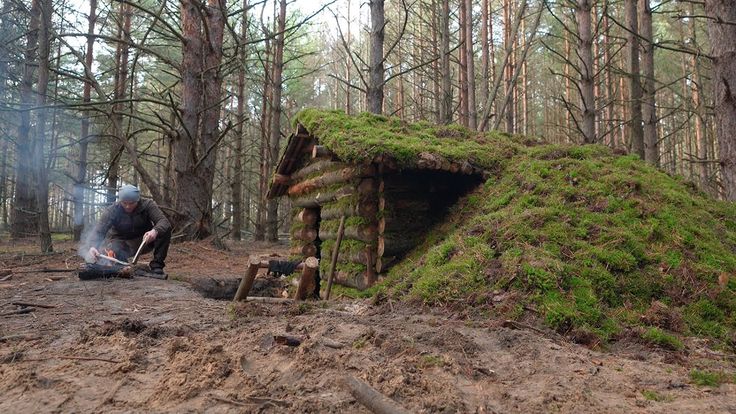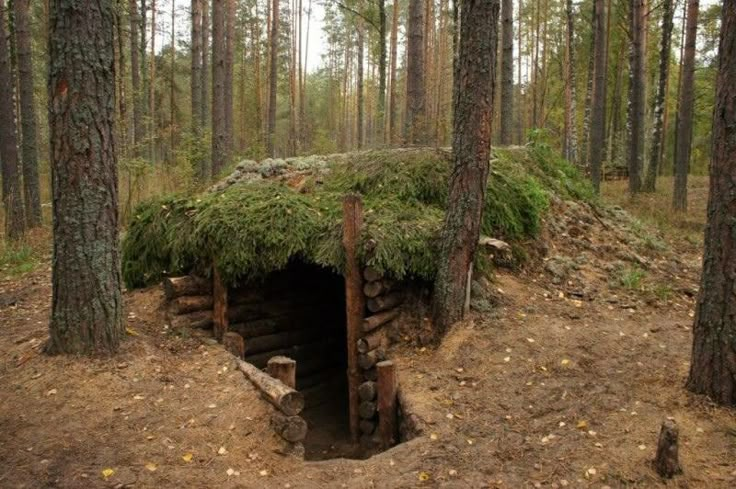The Hunter’s Hearth: Building a Warm Off-Grid Bushcraft Shelter with a Natural Fireplace
Imagine the crisp air of a hunting expedition, the need for a reliable basecamp deep in the wilderness. Instead of modern tents, envision a sturdy off-grid hunter hut built entirely from the land, its heart glowing with the comforting crackle of a natural fireplace. This embodies bushcraft and self-reliance. How do you transform the raw materials of the forest into such a haven? What are the essential steps to construct a bushcraftlter with a natural fireplace that provides warmth, security, and a base for your hunting endeavors? This comprehensive guide unveils the secrets to building a functional and warm natural materials survival shelter specifically tailored for the off-grid hunter, complete with a safe and efficient wilderness hunting shelter with fire.

Section 1: The Hunter’s Need: Designing a Functional Off-Grid Bushcraft Shelter
Designing an off-grid hunting basecamp using bushcraft principles must directly address a hunter’s specific requirements. This functional bushcraft hut needs to offer reliable protection from the elements, providing shelter from rain, snow, wind, and sun. Secure storage for essential hunting gear, tools, and processed game is crucial. A warm space for rest, recuperation, and cooking is paramount, especially during colder months. Depending on the hunting strategy, incorporating potential vantage points or observation windows into the design might also prove beneficial. When planning your hunter shelter design, balance the desired size and complexity with the realistic time and effort you can dedicate to construction. Strategic shelter location is equally vital; prioritize proximity to hunting grounds and reliable water sources while considering natural windbreaks and stable, well-drained terrain.

Section 2: Sourcing Nature’s Building Blocks: Identifying and Gathering Materials
The foundation of any successful primitive shelter building lies in the careful selection and responsible gathering of natural shelter-building materials. For the wooden frame bushcraft shelter, identify straight, sturdy saplings and branches of appropriate species known for their strength and workability. Consider locally abundant options to minimize environmental impact. For natural insulation for shelter, gather materials like dry leaves, moss, pine needles, and ethically and legally obtained animal hides. Primitive roofing materials can include large sheets of bark (birch or poplar), broad leaves (like those from palms in warmer climates), or tightly woven grasses and reeds. If available, locate suitable stones and clay in the vicinity for constructing a safe and functional fireplace in the wilderness. Always prioritize sustainable harvesting practices, taking only what you need and minimizing disturbance to the surrounding environment.

Section 3: Building the Bones: Constructing a Sturdy Wooden Frame
The structural integrity of your wilderness hunting shelter relies on a well-constructed wooden frame bushcraft shelter. Simple yet effective designs like the lean-to, the classic A-frame, or a modified debris hut frame (enlarged for more interior space) are excellent starting points. Mastering primitive wood joinery techniques is essential. Utilize natural cordage crafted from vines, roots, or strips of bark for lashing techniques to shelter and securely bind the wooden elements together. Ensure the frame is inherently stable, capable of withstanding strong winds, and robust enough to support the weight of the roof and potential snow accumulation. A well-built, sturdy shelter construction forms the backbone of your off-grid haven.

Section 4: The Heart of Warmth: Integrating a Natural Fireplace
A natural fireplace bushcraft shelter transforms a basic survival structure into a warm and inviting basecamp. Design a safe and contained fireplace, carefully considering its size and placement within the shelter to minimize fire hazards. Construct a basic fire pit using stones (if readily available) or by clearing a designated area and creating low earthen walls to contain the flames. If possible and necessary for better smoke management, implement a simple primitive chimney design using stacked stones or a framework of sticks plastered with clay. Adhering to crucial fire safety in shelter protocols is paramount. Maintain a safe distance between the fireplace and any flammable materials within the shelter, and always have a readily available method for extinguishing flames quickly, such as a container of water or sand. A well-designed fireplace provides essential warmth for cold nights and a means for cooking gathered food.

Section 5: Walls and Roof: Providing Protection from the Elements
Creating effective walls and a roof is crucial for a comfortable and functional natural materials survival shelter. Employ natural shelter wall construction techniques such as weaving branches together to form wattle walls, packing the gaps with insulating bushcraft shelter materials like leaves or moss, or leaning poles against the frame and covering them with layers of bark. For primitive roofing techniques that shed water effectively, utilize overlapping layers of bark, large leaves arranged like shingles, or tightly thatched bundles of grasses or reeds. Ensure adequate insulation in the walls and roof to retain heat in cold conditions. Minimize drafts and entry points for wind and rain by carefully sealing any gaps or openings in the walls and roof. This weatherproofing natural shelter is key to long-term comfort.
Section 6: Step-by-Step Build: A Hunter’s Off-Grid Shelter (Conceptual)
While the specifics will vary based on location and available materials, a general building hunter shelter guide follows these steps: First, carefully select and prepare your site. Next, gather your initial building materials. Then, construct the sturdy wooden frame bushcraft shelter. Following the frame, build your natural fireplace bushcraft shelter, ensuring it is safe and functional. Create the walls using your chosen natural shelter wall construction techniques. Build a waterproof roof using your gathered primitive roofing materials. Finally, add insulation to the walls and roof for warmth and comfort in this DIY off-grid hut.

Section 7: Enhancing Comfort and Functionality for the Hunter
Beyond basic shelter, consider enhancements that cater specifically to the hunter’s needs. Construct a raised sleeping platform from logs and branches to provide insulation from the cold ground and keep you and your gear dry. Build simple storage solutions using branches or woven materials to keep hunting gear, tools, and processed game organized and off the ground. Improve light penetration (e.g., small openings covered with translucent materials if available). Consider long-term bushcraft shelter use and plan for potential maintenance and repairs.
Section 8: Safety First: Fire Prevention and Wilderness Awareness
Prioritizing safety is paramount when building and occupying an off-grid hunter hut fireplace. Adhere to strict fire safety bushcraft shelter practices when building and maintaining your natural fireplace. Prevent wildfires by clearing a wide area around your shelter of any flammable vegetation and managing your fuel responsibly. Be acutely aware of potential wildlife encounters in your chosen location and take necessary precautions for shelter security. Ensure adequate ventilation within the shelter, especially when using the fireplace, to prevent the buildup of dangerous carbon monoxide. Practicing good wilderness safety habits for hunters will ensure a safe and successful stay in your natural haven.

Section 9: Adapting to the Land: Environmental Considerations
The most successful environmental adaptation shelter utilizes locally abundant natural shelter-building materials, minimizing your impact on the surrounding ecosystem. Tailor your shelter design and material selection to the specific climate (cold, temperate, warm) and terrain (forest, mountains) of your hunting area. Utilizing locally abundant natural shelter-building materials minimizes your impact and maximizes efficiency. Consider the prevailing weather patterns, such as wind direction and typical rainfall, and orient your shelter accordingly for maximum protection. Embrace the principles of sustainable wilderness building, working in harmony with the land to create a functional and responsible off-grid haven.

(Conclusion)
Building a warm and functional off-grid hunter hut with a natural fireplace from the resources of the wilderness is a deeply rewarding endeavor. It embodies the core principles of bushcraft, self-reliance, and a profound connection with the natural world. By carefully considering the hunter’s needs, responsibly sourcing materials, employing sound construction techniques, prioritizing safety, and adapting to the environment, you can create a truly invaluable basecamp—a testament to your skills and a warm hearth in the heart of the wild.
Call to Action:
What are your essential considerations when building a wilderness shelter for hunting or extended stays off-grid? Have you ever incorporated a natural fireplace into your shelter designs? Share your experiences and hard-earned wisdom in the comments below! If you’re passionate about bushcraft and self-reliance, explore our other articles and resources on shelter building, firecraft, and sustainable living in nature.